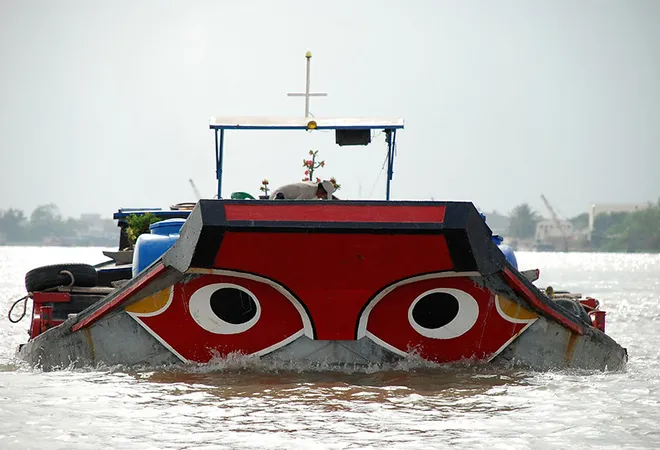
The joint naval exercise
conducted in the South China Sea between India and Vietnam last week follows two significant virtual meetings. Indian Prime Minister, Narendra Modi, and his Vietnamese counterpart, Nguyen Xuan Phuc, held a virtual
summit on 21 December; and a bilateral
meeting between Defence Minister Rajnath Singh and his Vietnamese counterpart General Ngo Xuan Lich was held in late November.
India’s growing strategic ties with Vietnam again confirms a trend that Delhi’s security cooperation with nations in the Mekong subregion remain largely at the bilateral and regional levels. India has developed strong security partnerships with Southeast Asian nations at the regional level through the various ASEAN-led processes including ASEAN Regional Forum (ARF) or the ASEAN Defence Minister's Meeting Plus (ADMM). A dimension that has not received much attention in India’s security ties with the Mekong subregion is cooperation at subregional level.
India’s growing strategic ties with Vietnam again confirms a trend that Delhi’s security cooperation with nations in the Mekong subregion remain largely at the bilateral and regional levels.
At the virtual summit, India and Vietnam have agreed to enhance their defence and security partnership by stepping up “military-to-military exchanges, training and capacity building programmes across the three services and coast guards” and to “intensify their defence industry collaboration building on India’s defence credit lines extended to Vietnam.” Earlier, India and Vietnam signed an implementation agreement on hydrography at the bilateral meeting between the defence ministers.
Among the Mekong nations, India’s defence and security ties with Vietnam and Myanmar have a strong geopolitical dimension in the context of China’s assertiveness in the region. Both Vietnam and Myanmar engage China but remain wary and have adopted a cautious approach. Vietnam has been locked in a maritime territorial dispute with China in the South China Sea. Myanmar has its concerns about the role of China in its country and has been diversifying its strategic options to minimise dependence on its northern neighbour.
Myanmar and Vietnam are located geo-strategically in the Mekong subregion, with both having long coastlines in the Bay of Bengal and the South China Sea, respectively.
The geostrategic significance of the Mekong subregion for India could be seen both from the continental and maritime perspectives. Myanmar and Vietnam are located geo-strategically in the Mekong subregion, with both having long coastlines in the Bay of Bengal and the South China Sea, respectively.
Though the subregional mechanism, the Mekong-Ganga Cooperation (MGC), exists — through which India engages with the five nations in the Mekong subregion — it focuses on socio-economic and cultural cooperation such as connectivity, trade, tourism, etc. The MGC could explore new areas of cooperation including non-traditional security issues and potentials for such collaboration are high. However, not all members of the subregional grouping may share the same strategic goals for subregional security cooperation involving traditional security issues.
Myanmar and Vietnam share a common strategic outlook that aligns with India’s strategic calculations.
Even so, there are other arrangements that can be explored. For instance, a trilateral security cooperation involving India, Vietnam and Myanmar, that focuses on defence and security areas such as capacity building, joint exercises and trainings, etc. could be a starting point. There are a couple of advantages in involving Vietnam and Myanmar for such a trilateral security cooperation.
Myanmar and Vietnam share a common strategic outlook that aligns with India’s strategic calculations. The two Mekong nations also enjoy cordial bilateral relations driven not only by their shared strategic interests, but also because both countries do not suffer from bilateral tensions that is common among immediate neighbours in the Mekong subregion, including between Thailand and Myanmar, over cross-border illegal movements and activities.
On the other hand, in November, India concluded the second edition of the India, Thailand and Singapore trilateral naval exercise (SITMEX-20) in the Andaman Sea. This series has been initiated with the “aim to strengthen mutual confidence and develop common understanding.” The SITMEX series of exercise involves Thailand, a member from the MGC.
It is in Delhi’s interests to explore security cooperation at various levels.
Furthermore, the subregional grouping, Bay of Bengal Initiative for Multisectoral Technical and Economic Cooperation (BIMSTEC) — where two Mekong nations, Myanmar and Thailand are members — has already initiated subregional security cooperation with the first BIMSTEC military exercise conducted in 2019.
India has been engaging in trilateral and subregional security cooperation with its neighbours including with nations in the Mekong subregion. The growing strategic ties with Mekong nations such as Vietnam and Myanmar indicate deepening mutual trust in the rapidly changing regional geopolitics.
It is in Delhi’s interests to explore security cooperation at various levels and the current evolving regional power dynamics provides an opportune moment for Delhi to consider such an arrangement with two strategic partners in the Mekong subregion.
The views expressed above belong to the author(s). ORF research and analyses now available on Telegram! Click here to access our curated content — blogs, longforms and interviews.



 The joint naval exercise
The joint naval exercise  PREV
PREV


